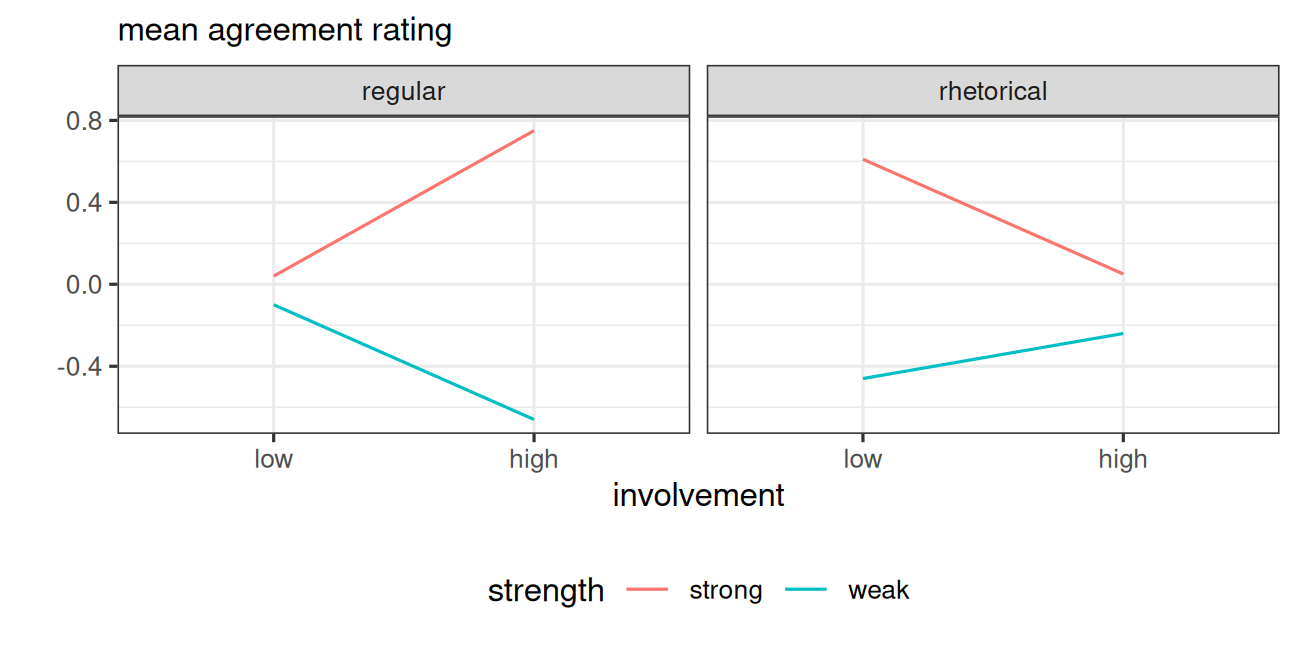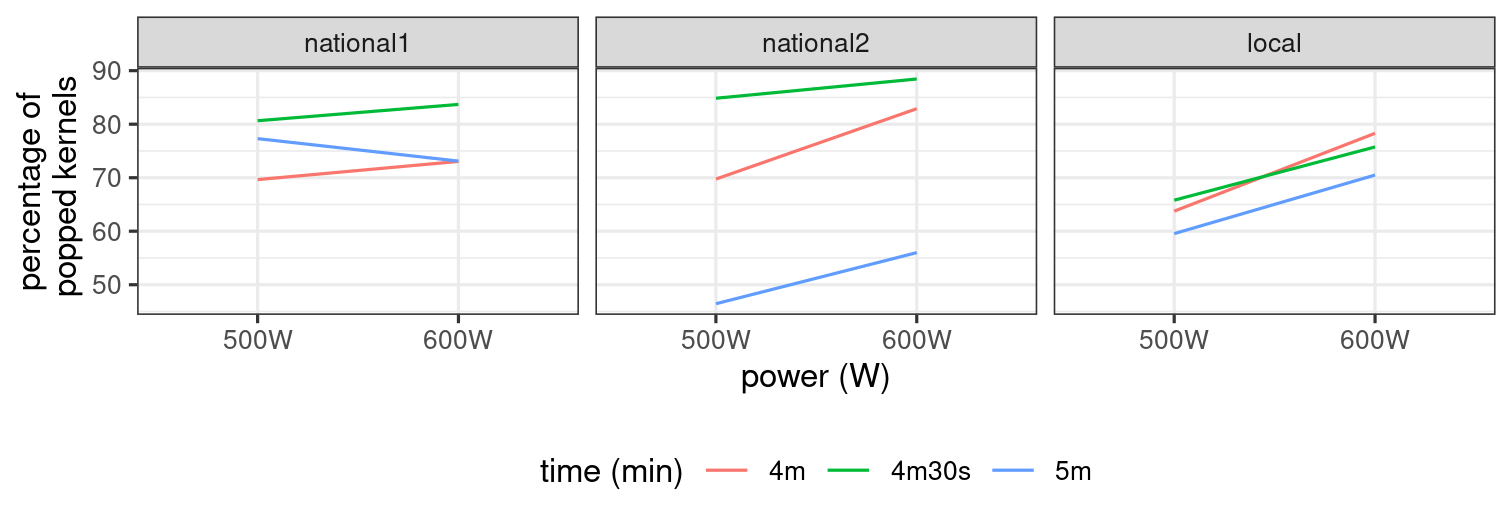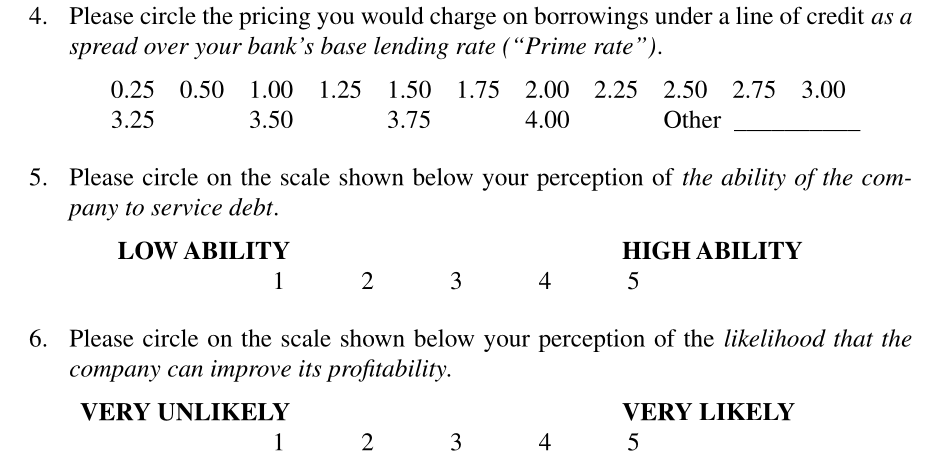Multiway ANOVA and MANOVA
Session 7
MATH 80667A: Experimental Design and Statistical Methods
HEC Montréal
Outline
Multiway ANOVA
MANOVA
Multifactorial designs
Beyond two factors
We can consider multiple factors A, B, C, … with respectively na, nb, nc, … levels and with nr replications for each.
The total number of treatment combinations is
na×nb×nc×⋯
Beyond two factors
We can consider multiple factors A, B, C, … with respectively na, nb, nc, … levels and with nr replications for each.
The total number of treatment combinations is
na×nb×nc×⋯
Curse of dimensionality
Full three-way ANOVA model
Each cell of the cube is allowed to have a different mean
Yijkrμjresponsecell=μijkcell mean+εijkrμjerrorcell with εijkt are independent error term for
- row i
- column j
- depth k
- replication r
Parametrization of a three-way ANOVA model
With the sum-to-zero parametrization with factors A, B and C, write the response as
E(Yijkr)theoretical average=μglobal mean+αi+βj+γkmain effects+(αβ)ij+(αγ)ik+(βγ)jktwo-way interactions+(αβγ)ijkthree-way interaction




global mean, row, column and depth main effects




row/col, row/depth and col/depth interactions and three-way interaction.
Example of three-way design
Petty, Cacioppo and Heesacker (1981). Effects of rhetorical questions on persuasion: A cognitive response analysis. Journal of Personality and Social Psychology.
A 2×2×2 factorial design with 8 treatments groups and n=160 undergraduates.
Setup: should a comprehensive exam be administered to bachelor students in their final year?
- Response Likert scale on −5 (do not agree at all) to 5 (completely agree)
- Factors
- A: strength of the argument (
strongorweak) - B: involvement of students
low(far away, in a long time) orhigh(next year, at their university) - C: style of argument, either
regularform orrhetorical(Don't you think?, ...)
Interaction plot
Interaction plot for a 2×2×2 factorial design from Petty, Cacioppo and Heesacker (1981)

p.472 of Keppel and Wickens
The microwave popcorn experiment
What is the best brand of microwave popcorn?
- Factors
- brand (two national, one local)
- power: 500W and 600W
- time: 4, 4.5 and 5 minutes
- Response:
weight,volume,number, percentage of popped kernels. - Pilot study showed average of 70% overall popped kernels (10% standard dev), timing values reasonable
- Power calculation suggested at least r=4 replicates, but researchers proceeded with r=2...
ANOVA table
data(popcorn, package = 'hecedsm')# Fit model with three-way interactionmodel <- aov(percentage ~ brand*power*time, data = popcorn)# ANOVA table - 'anova' is ONLY for balanced designsanova_table <- anova(model) # Quantile-quantile plotcar::qqPlot(model)Model assumptions: plots and tests are meaningless with nr=2 replications per group...
Quantile-quantile plot

All points fall roughly on a straight line.
Code for interaction plot
popcorn |> group_by(brand, time, power) |> summarize(meanp = mean(percentage)) |>ggplot(mapping = aes(x = power, y = meanp, col = time, group = time)) + geom_line() + facet_wrap(~brand)Interaction plot

No evidence of three-way interaction (hard to tell with r=2 replications).
Variance decomposition for balanced designs
| terms | degrees of freedom |
|---|---|
| A | na−1 |
| B | nb−1 |
| C | nc−1 |
| AB | (na−1)(nb−1) |
| AC | (na−1)(nc−1) |
| BC | (nb−1)(nc−1) |
| ABC | (na−1)(nb−1)(nc−1) |
| residual | nanbnc(R−1) |
| total | nanbncnr−1 |
Analysis of variance table for the 3-way model
| Degrees of freedom | Sum of squares | Mean square | F statistic | p-value | |
|---|---|---|---|---|---|
| brand | 2 | 331.10 | 165.55 | 1.89 | 0.180 |
| power | 1 | 455.11 | 455.11 | 5.19 | 0.035 |
| time | 2 | 1554.58 | 777.29 | 8.87 | 0.002 |
| brand:power | 2 | 196.04 | 98.02 | 1.12 | 0.349 |
| brand:time | 4 | 1433.86 | 358.46 | 4.09 | 0.016 |
| power:time | 2 | 47.71 | 23.85 | 0.27 | 0.765 |
| brand:power:time | 4 | 47.33 | 11.83 | 0.13 | 0.967 |
| Residuals | 18 | 1577.87 | 87.66 |
Omitting terms in a factorial design
The more levels and factors, the more parameters to estimate (and replications needed)
- Costly to get enough observations / power
- The assumption of normality becomes more critical when r=2!
It may be useful not to consider some interactions if they are known or (strongly) suspected not to be present
- If important interactions are omitted from the model, biased estimates/output!
Guidelines for the interpretation of effects
Start with the most complicated term (bottom up)
- If the three-way interaction ABC is significative:
- don't interpret main effects or two-way interactions!
- comparison is done cell by cell within each level
- If the ABC term isn't significative:
- can marginalize and interpret lower order terms
- back to a series of two-way ANOVAs
Marginalization vs main effects
Marginalization means that we reduce the dimension of the problem, e.g., we transform a three-way ANOVA into a two-way ANOVA by collapsing over a dimension.
Main effects are the effects of factors A, B, C (i.e., row, column and depth effects).
What contrasts are of interest?
- Can view a three-way ANOVA as a series of one-way ANOVA or two-way ANOVA...
Depending on the goal and if the interactions are significative or not, could compare for variable A
- marginal contrast ψA (averaging over B and C)
- marginal conditional contrast for particular subgroup: ψA within c1
- contrast involving two variables: ψAB
- contrast differences between treatment at ψA×B, averaging over C.
- etc.
See helper code and chapter 22 of Keppel & Wickens (2004) for a detailed example.
Effects and contrasts for microwave-popcorn
Following preplanned comparisons
- Which combo (brand, power, time) gives highest popping rate? (pairwise comparisons of all combos)
- Best brand overall (marginal means marginalizing over power and time, assuming no interaction)
- Effect of time and power on percentage of popped kernels
- pairwise comparison of time × power
- main effect of power
- main effect of time
Preplanned comparisons using emmeans
Let A=brand, B=power, C=time
Compare difference between percentage of popped kernels for 4.5 versus 5 minutes, for brands 1 and 2
H0:(μ1.2−μ1.3)−(μ2.2−μ2.3)=0
library(emmeans)# marginal meansemm_popcorn_AC <- emmeans(model, specs = c("brand","time"))contrast_list <- list( brand12with4.5vs5min = c(0, 0, 0, 1, -1, 0, -1, 1,0))contrast(emm_popcorn_AC, # marginal mean (no time) method = contrast_list) # list of contrastsPreplanned comparisons
Compare all three times (4, 4.5 and 5 minutes)
At level 99% with Tukey's HSD method
- Careful! Potentially misleading because there is a
brand * timeinteraction present.
# List of variables to keep go in `specs`: keep only timeemm_popcorn_C <- emmeans(model, specs = "time")pairs(emm_popcorn_C, adjust = "tukey", level = 0.99, infer = TRUE)Multivariate analysis of variance
Motivational example
From Anandarajan et al. (2002), Canadian Accounting Perspective
This study questions whether the current or proposed Canadian standard of disclosing a going-concern contingency is viewed as equivalent to the standard adopted in the United States by financial statement users. We examined loan officers’ perceptions across three different formats
Alternative going-concern reporting formats
Bank loan officers were selected as the appropriate financial statement users for this study.
Experiment was conducted on the user’s interpretation of a going-concern contingency when it is provided in one of three disclosure formats:
- Integrated note (Canadian standard)
- Stand-alone note (Proposed standard)
- Stand-alone note plus modified report with explanatory paragraph (standard adopted in US and other countries)
Multivariate response

Why use MANOVA?
- Control experimentwise error
- do a single test instead of J univariate ANOVAs, thereby reducing the type I error
- Detect differences in combination that would not be found with univariate tests
- Increase power (context dependent)
Multivariate model
Postulate the following model: Yij∼Normalp(μj,Σ),j=1,…J
Each response Yij is p-dimensional.
We assume multivariate measurements are independent of one another, with
- the same multivariate normal distribution
- same covariance matrix Σ (each measurement can have different variance)
- same mean vector μj within each j=1,…,J experimental groups.
The model is fitted using multivariate linear regression.
Model fitting with multivariate response
In R, we fit a model binding the different vectors of response in a matrix with p columns
data(AVC02, package = "hecedsm")# Fit the model binding variables with cbind# on left of tilde (~) symbolmodMANOVA <- manova( cbind(prime, debt, profitability) ~ format, data = AVC02)Bivariate MANOVA

Confidence ellipses for bivariate MANOVA with discriminant analysis.
We use the correlation between the p measurements to find better discriminant (the diagonal line is the best separating plane between the two variables).
Confidence intervals and confidence regions

Simultaneous confidence region (ellipse), marginal confidence intervals (blue) and Bonferroni-adjusted intervals (green).
The dashed lines show the univariate projections of the confidence ellipse.
Model assumptions
The more complex the model, the more assumptions...
Same as ANOVA, with in addition
- The response follow a multivariate normal distribution
- Shapiro–Wilk test, univariate Q-Q plots
- The covariance matrix is the same for all subjects
- Box's M test is often used, but highly sensitive to departures from the null (other assumptions impact the test)
Normality matters more in small samples (but tests will often lead to rejection, notably because of rounded measurements or Likert scales)
When to use MANOVA?
In addition, for this model to make sense, you need just enough correlation (Goldilock principle)
- if correlation is weak, use univariate analyses
- (no gain from multivariate approach relative to one-way ANOVAs)
- less power due to additional covariance parameter estimation
- if correlation is too strong, redundancy
- don't use Likert scales that measure a similar dimension (rather, consider PLS or factor analysis)
Only combine elements that theoretically or conceptually make sense together.
Testing equality of mean vectors
The null hypothesis is that the J groups have the same mean
H0:μ1=⋯=μJ against the alternative that at least one vector is different from the rest.
The null imposes (J−1)×p restrictions on the parameters.
The test statistic is Hotelling's T2 (with associated null distribution), but we can compute using an F distribution.
Choice of test statistic
In higher dimensions, with J≥3, there are many statistics that can be used to test equality of mean.
The statistics are constructed from within/between sum covariance matrices.
These are
- Roy's largest root (most powerful provided all assumptions hold)
- Wilk's Λ: most powerful, most commonly used
- Pillai's trace: most robust choice for departures from normality or equality of covariance matrices
Most give similar conclusion, and they are all equivalent with J=2.
Results for MANOVA
summary(modMANOVA) # Pilai is default## Df Pillai approx F num Df den Df Pr(>F)## format 2 0.02581 0.55782 6 256 0.7637## Residuals 129summary(modMANOVA, test = "Wilks")## Df Wilks approx F num Df den Df Pr(>F)## format 2 0.97424 0.5561 6 254 0.765## Residuals 129summary(modMANOVA, test = "Hotelling-Lawley")## Df Hotelling-Lawley approx F num Df den Df Pr(>F)## format 2 0.026397 0.55434 6 252 0.7664## Residuals 129summary(modMANOVA, test = "Roy") # not reliable here?## Df Roy approx F num Df den Df Pr(>F)## format 2 0.024436 1.0426 3 128 0.3761## Residuals 129MANOVA for repeated measures
We can also use MANOVA for repeated measures to get away from the hypothesis of equal variance per group or equal correlation.
model <- afex::aov_ez( id = "id", # subject id dv = "latency", # response within = "stimulus", # within-subject data = hecedsm::AA21, fun_aggregate = mean)model$Anova # for models fitted via 'afex'Output
## ## Type III Repeated Measures MANOVA Tests: Pillai test statistic## Df test stat approx F num Df den Df Pr(>F) ## (Intercept) 1 0.95592 238.56 1 11 8.373e-09 ***## stimulus 1 0.09419 0.52 2 10 0.6098 ## ---## Signif. codes: 0 '***' 0.001 '**' 0.01 '*' 0.05 '.' 0.1 ' ' 1Less powerful than repeated measures ANOVA because we have to estimate more parameters. Still assumes that the covariance structure is the same for each experimental group.
Follow-up analyses
Researchers often conduct post hoc univariate tests using univariate ANOVA. In R, Holm-Bonferonni's method is applied for marginal tests (you need to correct for multiple testing!)
# Results for univariate analysis of variance (as follow-up)summary.aov(modMANOVA)# Note the "rep.meas" as default name # to get means of each variable separatelyemmeans::emmeans(modMANOVA, specs = c("format", "rep.meas"))A better option is to proceed with descriptive discriminant analysis, a method that tries to find the linear combinations of the vector means to discriminate between groups. Beyond the scope of the course.